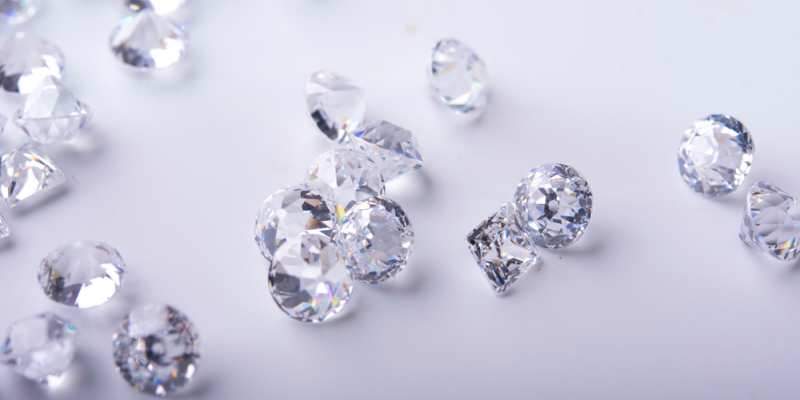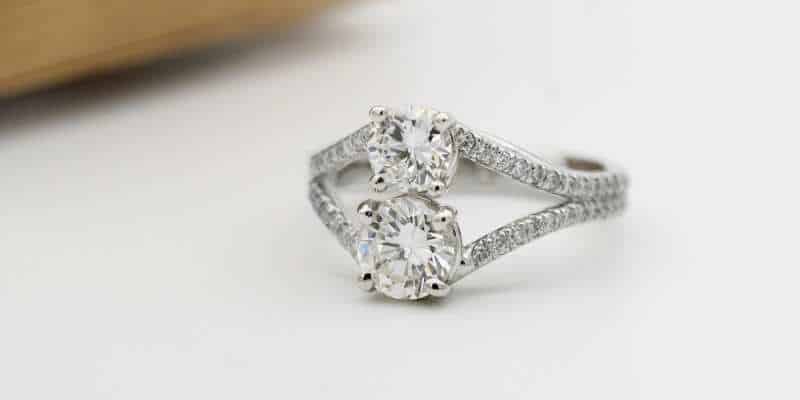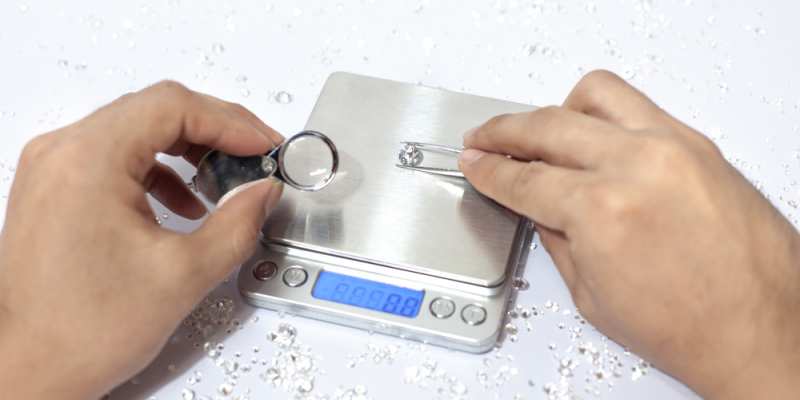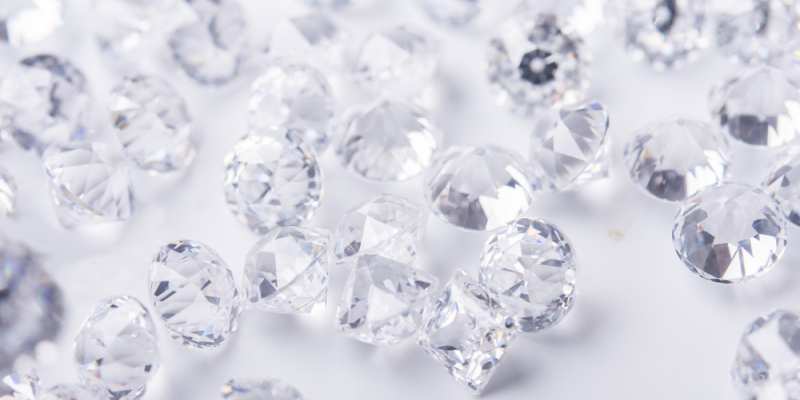Tiny diamonds, commonly referred to as melee diamonds, can enhance the beauty of a larger center stone and add sparkle to a plain ring. This raises the question: What is the value of these small diamonds?
The price of tiny diamonds can vary based on their grade, with the average cost typically ranging in the hundreds of dollars. Higher-quality melee diamonds command a higher price.
Several factors influence the price of these petite gems, and it’s important to understand their applications. In this article, we will explore these aspects and provide answers to your questions. Be sure to read on until the end to gain a comprehensive understanding.
DESIGN YOUR OWN ENGAGEMENT RING: START WITH A SETTING OR START WITH A DIAMOND. IT’S REALLY UP TO YOU!

What Are Melee Diamonds?
Melee diamonds, also known as tiny diamonds, are commonly used in jewelry to accentuate a larger center gemstone, particularly on engagement rings. These small diamonds are often seen in settings like halos, channels, or pave designs.
According to the Gemological Institute of America (GIA), melee diamonds are defined as diamonds that are less than 0.2 carats. However, they can also be as tiny as 0.001 carats. Due to their size, melee diamonds may not have much visual impact when viewed individually. However, when grouped together, they can create a stunning sparkle and enhance the overall appearance of a plain engagement ring.
In terms of their cut, most melee diamonds are cut in the same way as larger brilliant-cut diamonds, resulting in a scaled-down version of the round brilliant diamond often used as a center stone. These are referred to as Full Cut melee diamonds, featuring 58 facets. On the other hand, there are Single Cut melee diamonds, which have simpler cutting techniques and only 17 facets. However, Single Cut melee diamonds are rarely used nowadays, as modern diamond cutting techniques have advanced significantly.
When it comes to pricing, the value of melee diamonds depends on their size and the quality of the cut. Since melee diamonds are small, they are not highly valuable individually. Instead, they are typically sold in wholesale parcels containing hundreds of tiny diamonds to jewelry designers and repairers. The price of melee diamonds is often calculated based on the total carat weight of the parcel.
On average, melee diamonds can cost around $300-400 per carat for average-grade gems. However, higher-grade melee diamonds with better clarity (VVS/VS) and color (higher than H) can reach prices of up to $1000 per carat. It’s important to note that melee diamonds are often sold in bulk rather than individually on the commercial market.

Melee Diamonds: Ring Settings
Melee diamonds, also known as tiny diamonds, are used in ring settings to create a dazzling display of sparkle, brilliance, and fire, particularly in engagement rings. These small diamonds are ideal for adding overall shine and volume to a ring without overshadowing the center diamond.
Some popular ring settings that incorporate melee diamonds include the pave, channel, and halo settings.
Pave Ring Setting
In a pave ring setting, the shank of the ring is lined with tiny diamonds, creating the illusion of a continuous line of sparkle. The diamonds are typically set as small as 0.01-0.02 carats, with even smaller stones known as micro-paves set in thin bands. The diamonds are delicately placed into drilled holes in the band and secured with mini-prongs or small beads. The result is a ring that exudes continuous shine and sparkle. Pave settings can complement various styles and can be paired with other settings such as halos, solitaires, and three-stone rings.
Halo Ring Setting
In a halo ring setting, the center stone is surrounded by a loop of tiny diamonds, usually arranged in a concentric circle. The halo of diamonds enhances the appearance and brilliance of the center stone, making it appear larger. Halo settings can be paired with pave bands or stand alone with an unadorned band. Some halo settings feature double halos or hidden halos, further adding brilliance and character to the ring.
Channel Ring Setting
A channel-set ring setting involves placing tiny diamonds inside a specially cut channel. The channel secures the diamonds, and in some cases, grooves are added for extra stability. Channel settings use thicker metal to hold the diamonds in place, creating a snag-free design. This setting adds style and sparkle to the ring, making it an attractive choice for wedding bands and stackable rings. The channel setting securely holds the diamonds while maintaining a sleek and stable design.
Each ring setting has its advantages and disadvantages, and it’s important to consider factors such as maintenance, resizing difficulties, and the risk of diamond loss. However, when properly cared for, these ring settings can showcase the beauty of melee diamonds and create stunning pieces of jewelry.

What To Look For When Buying A Ring With Melee Diamonds
When purchasing a ring, there is often limited opportunity to customize the melee diamonds. However, it is still important to ensure that the melee diamonds are of a high enough grade. Otherwise, they may detract from the value of the center gemstone.
Unlike the center gem, grading reports are not typically available for the tiny diamonds surrounding it. This allows some jewelers to make false claims about the quality of the melee diamonds to offer lower prices. It is essential to be cautious of such practices and ensure that the melee diamonds meet your desired standards.
It is also crucial to consider the balance between the melee diamonds and the center diamond. While a collection of brilliant melee diamonds can provide a stunning shine to the ring, you want the center diamond to remain the focal point. The melee diamonds should enhance the overall beauty without overshadowing the center stone.
Another aspect to keep in mind is that melee diamonds are more prone to displacement. A ring with numerous melee diamonds may require regular maintenance to ensure none of them become loose or fall out. Nothing diminishes the appeal of a ring more than missing melee diamonds.
Diamond Chips
Diamond chips are small diamonds that can be used in similar settings as melee diamonds. However, they are not fully faceted like traditional diamonds. As a result, diamond chips have jagged and uneven shapes compared to properly cut melee diamonds.
Diamond chips are often remnants from the cutting process of larger stones or small diamonds that have not been cut. Without the facets, diamond chips lack the same impact and sparkle. Their shine solely comes from light reflecting off their surface at uneven angles.
Diamond Chip Prices
Diamond chips are not commonly used in jewelry today. However, when they are used, they serve as a low-cost substitute for melee diamonds. Due to their lack of cutting and processing, they are typically much cheaper.
While diamond chips may be significantly cheaper than melee diamonds, they should not be used as a cost-cutting measure for rings with accent diamonds. Their jagged and sharp shapes can depreciate the value of the center stone, and their uneven surfaces can be hazardous. Well-cut melee diamonds are a better choice for creating a timeless ring.
Understanding Diamond Prices
Diamond prices are determined by diamond cutters, suppliers, and market conditions. The process begins with rough diamonds being sold to manufacturers at auctions. Diamond manufacturers invest in labor and technology to precisely cut and polish diamonds, which incurs expenses.
The Rapaport organization helps establish benchmark prices by considering supply and demand conditions in collaboration with suppliers, manufacturers, and retailers. The Rapaport Price List provides wholesale diamond prices based on color, cut, carat, and clarity combinations.
Manufacturers then set pricing for the diamonds they offer in the market, which can be either a premium or a discount to the wholesale pricing recommendation. Prices vary based on various attributes such as color, cut, carat, clarity, symmetry, polish, length-width ratio, and fluorescence.
Diamond pricing has become highly competitive with the standardization provided by organizations like the Gemological Institute of America (GIA). It is important to note that the average diamond margin typically ranges from 7% to 12%.

Conclusion
If you’re still curious about the value of tiny diamonds, let’s break it down for you once again:
Tiny diamonds, also referred to as melee diamonds, are small gems that are often used to enhance the center gemstone of a ring. These diamonds are categorized as stones that are less than 0.2 carats in size. On average, melee diamonds are priced at around $300-400 per carat. However, higher-grade melee diamonds can reach prices of up to $1000 per carat.
Melee diamonds are commonly incorporated into ring settings to add extra sparkle and brilliance. Popular settings that feature melee diamonds include pave, halo, and channel settings.


